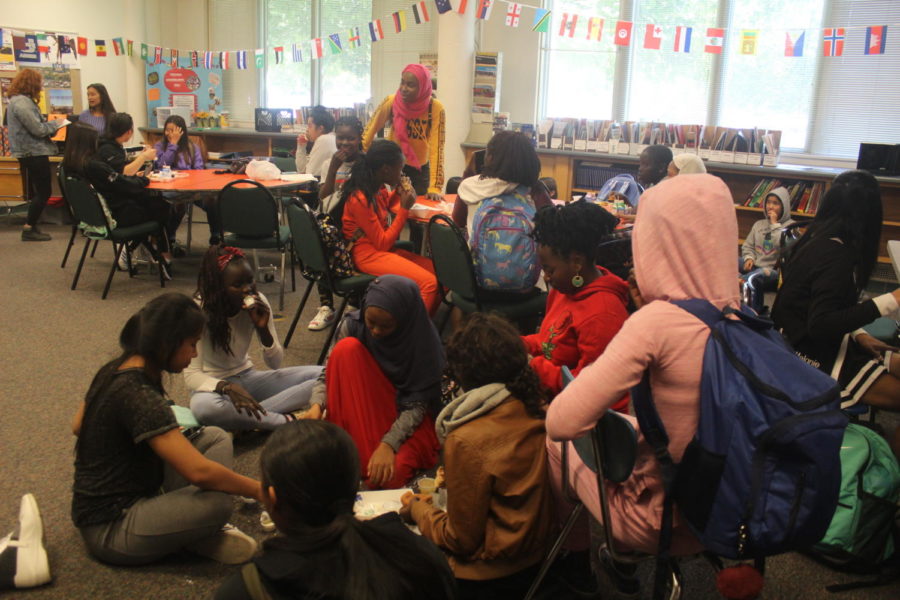Refugee Students See Highland As Sanctuary
Some of the refugee students at Highland gather together in room D106
October 3, 2018
Highland senior Paw Si came from a place of no freedom. Si once lived in Thailand with no food, no money, and no option of higher education. At home, Si and her family shared one bedroom in their small bamboo house, a house that her parents would sneak out of to go work. Things as simple as getting water required a five-minute walk.
Si and her family fled Thailand when she was only eight years old, but despite coming to America at such a young age, the change was unimaginable. The language barrier and change in lifestyle were incredibly difficult. Si came to school knowing nothing.
“Everything is new,” English language development teacher Elaine Toronto said regarding refugee students’ transition to Highland. “They have a lot of supports, but there’s so much for them to learn.”
A refugee is someone who has been forced out of their country and cannot safely return. Many of the refugee students at Highland have fled from their respective countries, waited for months, and been in a state of strife as they awaited their refugee status. Because of this, the emotional and social support they require is more than most.
Some of the supports are given to these students from the moment they enter the country. Each refugee student is assigned a sponsor and an agency which is meant to help them and their family get settled in a new environment. The agencies, often non-profit organizations, can help with a range of things from assisting the students’ parents find a job to setting up a new apartment.
As refugee students come to Highland, anything they need can be provided. Victoria Saley, Highland’s ESL advocate, has lined room D106 with clothes and school supplies that is available for any students that need it. Although Highland’s Ram Market is open to anyone who would like to pick up some food free of cost, it originally started as a place where refugee students could go to get the food they may need without worrying about the financial impact it would have on their family.
The process of a refugee student getting enrolled at Highland is quite simple. They go about the registration process very similarly to any new student. The only adjustment that is made is through their classes. Refugee students are put into English Second Language classes, or ESL classes, giving them support that other students don’t require.
“If a student has language needs, then they’re tested to see what level of English they know,” Highland principal Chris Jenson said.
Based on the students’ English proficiency level, the supports get built into their schedule. The higher their proficiency level, the less assistance they need. For example, a student with level one proficiency may need several ESL classes, while a student with level five proficiency would only require light monitoring to assure their success.
The transition into an American school would be difficult for anyone whose first language isn’t English, but it is especially challenging for the students coming from refugee camps.
“We have kids coming from more developed countries who already have really good background education, and they excel much quicker than the kids who’ve had disrupted education,” Toronto said. “A lot of my students that were in refugee camps maybe went to two or three years of school, then did school in the camps.”
Due to the unpredictable nature of their previous education, being thrown into the bell schedule that makes up public school takes plenty of time to adjust to.
“Some students have been here several years and just have not had the support to be able to learn as much,” Saley said. “We have some students who have been here about three years but they’re still at a level one or two while others have been here that long and they’re at a level four now.”
Students have as many ESL classes as is found to be necessary, but the refugee students are encouraged to take classes outside of their comfort zone, giving them the opportunity to experience the traditional American high school.
“We want them to have experiences in the mainstream as much has possible too because it’s really important to get a feel for the culture they’re living in now,” Jenson said. “But we are also very sensitive to trying to get them to maintain their own cultures.”
Jenson feels that one of Highland’s values is embracing different cultures, and feels that Highland’s diversity is what makes it so great.
“We learn as much from our friends coming from other countries around the world as they do from us,” Jenson said.
Outside of school hours, many of the refugee students receive extra help through the Youthlinc program. This program is for refugee students specifically to help with whatever they need in school or with their transition into Highland. Volunteers work with the refugee students, helping with anything they may be struggling with in school. The after-school time the refugees spend with Youthlinc volunteers gives them an opportunity to get work done while receiving the help they may need to gain an understanding of their material.
Along with aiding the refugee students in their school work, Youthlinc often takes the students out to do different activities to build a community they feel comfortable in as well as to expose them to the culture they have become a part of.
“School [in Thailand] was hard,” Si said. “We used to get hit with rulers if we did poorly.”
Many refugee students like Si see Highland as a sanctuary. To them, it is a school that offers opportunities they couldn’t have dreamt of having in their previous country.




























